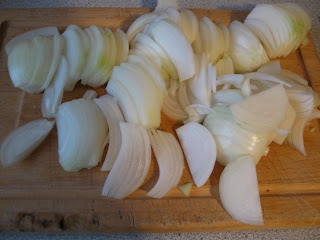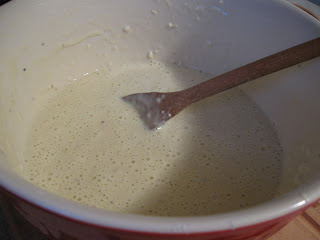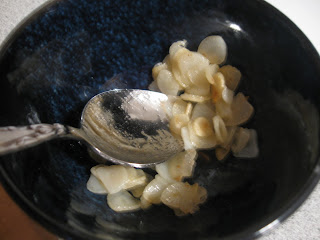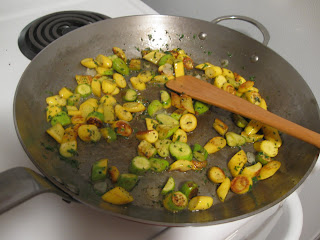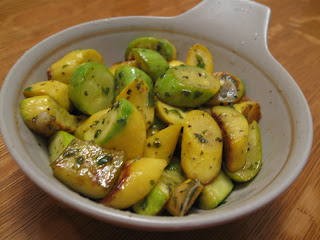I whipped up a spaghetti alla carbonara the other night for the girls, and once again found myself with three egg whites that I had no idea what to do with. I could have used them in an omelette, of course, but as you may have gleaned from the other posts in this blog, an egg white omelette is not exactly my style. What to do?
Gwyneth Paltrow to the rescue! I recently purchased her new cookbook, and was going through it to mark the recipes I want to try when I came across her recipe for pavlova. This dessert is basically baked egg whites, is super simple to prepare, and also happens to be delicious. I was in business! Incidentally, the cookbook is great. I originally purchased it because of the title: My Father's Daughter. As you may know, I'm a dad with daughters who wants to instill in his girls a love of food and cooking. The book naturally seemed like a good fit. In fact, I was really surprised just how personal and genuine the text is, and really enjoyed reading the accounts of Ms. Paltrow's memories of her dad, their meals, and the cooking they did together. I'd recommend the book for that alone, but it also has a stack of stellar recipes in there.
Pavlova was created in the 1920s to honour the Russian ballerina Anna Pavlova. There is some debate as to whether the creator was Australian or from New Zealand. I'm not touching that debate, but I have seen a pavlova with kiwis on it -- just sayin'.
Now for the math. The recipe calls for 4 egg whites. My carbonara recipe always leaves me with 3. I didn't want to add another one, since I'd then be stuck with an egg yolk and wouldn't have really solved anything with this whole enterprise (beam me up!). So I just multiplied everything in the recipe by 3/4 and was off to the races. So, you'll need three egg whites, 3/4 of a pinch of salt (I know, I'm hilarious), a little less than 1/2 teaspoon of white vinegar, 1/2 cup plus 1 tablespoon of granulated sugar (or 9/16 cup of sugar if you prefer -- neat that a tablespoon is 1/16 of a cup though), 3/4 tablespoon of cornstarch, and a little less than 1/2 tsp of vanilla. The blueberries and whipping cream are for the topping later (mmm...). Heat your oven to 350 ̊̊F now.
I never seem to have white vinegar in the house, so I used this stuff instead: vinegar made out of maple syrup. How cool is that? I love it in salad dressings, and figured the little boost of flavour could only make the pavlovas better.
The first step is to put the egg whites, vinegar, and salt in a mixing bowl and start whipping them up. Go full blast until you get soft peaks.
Meanwhile, mix the cornstarch and sugar together -- if your cornstarch has gotten a little lumpy get your fingers in there to break it up. Add the sugar mixture to the egg whites in thirds, stirring to fully incorporate each time.
Finally, put the vanilla in there and crank the mixer up again until you get stiff peaks (or peak, as the case may be) on the egg whites.
Put some parchment paper on a baking sheet and spoon the batter out into 6 rounds (the full recipe gets you 8). Flatten the meringues into circles, and put an indentation in the middle of each one while you're sculpting them. Put them in the 350 ̊F oven for 10 minutes, then lower the heat to 200 ̊̊F and bake them for one hour.
After an hour they should be a nice golden colour. Turn off the heat, prop the oven door open with a wooden spoon, and let them cool in the oven for another hour (this is a good day to make chicken stock since it keeps you puttering around near the kitchen too). Gwyneth specifically mentions the spoon in the door trick. My oven door will stay open by itself, but I think it stays open a little too much and would cool down too fast -- plus you never know if the door will get bumped into and closed by accident, so best to go with the spoon in the door plan. This is also a good idea if you have some kind of zealous door closer in your house. (Note, this is a nice way to warm up the kitchen on a cold November morning!)
When you're ready to eat, gently remove the meringues from the parchment paper and dress them up with some whipped cream and fruit. Gwyneth recommend blueberries, and I couldn't agree more. Strawberries would be great too. You could even use kiwis....
Egg whites could meet no finer fate. Приятного аппетита!
Sunday, November 13, 2011
Saturday, November 12, 2011
Onion and bacon tart. Oh, yes!
The latest issue of Saveur (no. 142) has a brillinat feature article on onions. I was flipping through it yesterday when my eyes lit upon this recipe. It seemed so amazing that I absolutely knew it had to be cooked-up as soon as possible. So here it is!
Incidentally, do yourself a favour and grab this issue. The onion centrefold (ish) is to die for, and there is also a great feature on Eastern European soups, which at this time of year is just what the doctor ordered. But I digress!
For this recipe, you'll need: 6 ounces of slab bacon, 4 tablespoons of butter (IT'S ALREADY AWESOME!), 2 yellow onions (I went for 3 just because), 1 1/2 cups of flour, 2 teaspoons of dry mustard, 1 1/4 cups of milk, and 3 eggs (even more brilliant! ANYTHING with bacon and eggs in it is like a dreamy recipe of breakfast wonderment!). But I digress again....
Step one is to cut your bacon into "matchsticks." This is what the recipe calls for, but I've never seen matchsticks quite so stubby, wobbly, and fat, but you get the idea. Fry you bacon on medium until it gets nice and crispy.
In the meantime, get the onions ready. The recipe says to slice them lengthwise. I was noticing though, that my onions were kind of stumpy, and what I would normally consider the length was in fact the width! Anyway, I cut them from root to stem in thin slices. You should too.
While all this is going on you should heat your oven to 425.
When the bacon is done, remove it to a plate with a slotted spoon. Pour the bacon fat into a 9" x 11" baking dish (see how awesome this is?!). Put the butter into the still warm skillet, and fry up your onions...
...until they are nice and carmelised. (Note the tongs -- you are supposed to "sprinkle" these onions on the batter later, but sprinkling isn't really an option with your fingers (they're hot!), hence the tongs.)
While the onions are cooking, prepare the batter. This is basically a Yorkshire pudding batter like we had in Toad in the Hole, but here the toads are a little smaller (my eldest suggested worms in the hole as an alternative.) In any event, the first step is to mix the flour, dry mustard, and pepper.
In a separate bowl, beat the eggs and mix in the milk.
Pour it all together, and work it around until mostly combined.
Let the batter rest for around 10 minutes. During that time, fire your baking dish into the oven to heat up. This is important, since if you pour a Yorkshire pudding batter into an ice-cold cast iron pan, you're in for some sad dissapointment. You need the boost of pan heat to get that dough headed skyward! (GET YOUR OVEN MITTS ON NOW!)
After ten minutes of resting and heating, pour you batter into the pan. (I HOPE YOU HAD YOUR OVEN MITTS ON!)
Add the onions and bacon (WOW!).
Have a beer! (EVEN BETTER!)
And put it back in the oven (WITH YOUR OVEN MITTS) for 30 minutes. And then, voila!! Brilliant!!!
It may take a little delicate manouvering to remove the tart from the pan, so be patient -- you can do it! (Note, those extra greasy bits stuck to the bottom taste REALLY good -- just sayin').
The recipe says this can serve 6. I cut it into 4, and, speaking from experience, I could eat the whole thing (if I wanted to, which I did). So this serves from 1 to 6, depending on the nature of your guests. (Don't invite me unless you make two!)
Viva l'ongion!!
Incidentally, do yourself a favour and grab this issue. The onion centrefold (ish) is to die for, and there is also a great feature on Eastern European soups, which at this time of year is just what the doctor ordered. But I digress!
For this recipe, you'll need: 6 ounces of slab bacon, 4 tablespoons of butter (IT'S ALREADY AWESOME!), 2 yellow onions (I went for 3 just because), 1 1/2 cups of flour, 2 teaspoons of dry mustard, 1 1/4 cups of milk, and 3 eggs (even more brilliant! ANYTHING with bacon and eggs in it is like a dreamy recipe of breakfast wonderment!). But I digress again....
Step one is to cut your bacon into "matchsticks." This is what the recipe calls for, but I've never seen matchsticks quite so stubby, wobbly, and fat, but you get the idea. Fry you bacon on medium until it gets nice and crispy.
In the meantime, get the onions ready. The recipe says to slice them lengthwise. I was noticing though, that my onions were kind of stumpy, and what I would normally consider the length was in fact the width! Anyway, I cut them from root to stem in thin slices. You should too.
While all this is going on you should heat your oven to 425.
When the bacon is done, remove it to a plate with a slotted spoon. Pour the bacon fat into a 9" x 11" baking dish (see how awesome this is?!). Put the butter into the still warm skillet, and fry up your onions...
...until they are nice and carmelised. (Note the tongs -- you are supposed to "sprinkle" these onions on the batter later, but sprinkling isn't really an option with your fingers (they're hot!), hence the tongs.)
While the onions are cooking, prepare the batter. This is basically a Yorkshire pudding batter like we had in Toad in the Hole, but here the toads are a little smaller (my eldest suggested worms in the hole as an alternative.) In any event, the first step is to mix the flour, dry mustard, and pepper.
In a separate bowl, beat the eggs and mix in the milk.
Pour it all together, and work it around until mostly combined.
Let the batter rest for around 10 minutes. During that time, fire your baking dish into the oven to heat up. This is important, since if you pour a Yorkshire pudding batter into an ice-cold cast iron pan, you're in for some sad dissapointment. You need the boost of pan heat to get that dough headed skyward! (GET YOUR OVEN MITTS ON NOW!)
After ten minutes of resting and heating, pour you batter into the pan. (I HOPE YOU HAD YOUR OVEN MITTS ON!)
Add the onions and bacon (WOW!).
Have a beer! (EVEN BETTER!)
And put it back in the oven (WITH YOUR OVEN MITTS) for 30 minutes. And then, voila!! Brilliant!!!
It may take a little delicate manouvering to remove the tart from the pan, so be patient -- you can do it! (Note, those extra greasy bits stuck to the bottom taste REALLY good -- just sayin').
The recipe says this can serve 6. I cut it into 4, and, speaking from experience, I could eat the whole thing (if I wanted to, which I did). So this serves from 1 to 6, depending on the nature of your guests. (Don't invite me unless you make two!)
Viva l'ongion!!
Tuesday, November 8, 2011
Potimarron squash soup: day 215.
Yowza! Two months without a post!! As you can see, my foray into the fine and admirable world of beer brewing has been taking a lot of my free time (both on the brewing front and the emptying-bottles-for-the-next-batch front). As several people have been attributed to saying, "Beer is proof that God loves us!" Amen to that, brothers and sisters. But I digress...
You're here for the squash soup recipe. Well, as luck would have it, my dear squashes decided to ripen the very day I was about to leave for Stockholm for a week. (Stockholm rocks, by the way. Special thanks to the Akkurat Pub for brilliant cask conditioned ales, The Delta Saints for a great show at the Akkurat on the day I arrived, and to my brilliant dance partners Julie, Alessandro, and Kristina who made Viveka's party a real hoot! But I digress again...).
ANYWAY, I knew that if I left my squashes in the garden while I was off dancing in Stockholm the squirrels would make them look like this (!) -- as they did with the poor sucker I left out "just to see."
Thankfully I had the presence of mind to harvest them when they looked like this, after which I hid them in the cold room in the basement (with all that beeeeeeer!) to await their fate in the soup pot a week later.
So, on with the recipe (finally!). You'll need 1 potimarron squash (see here to start your own 215 day odessey if they are not at your local store), 3 leeks (or two fat ones), 3 cups of milk, about 3 cups of water, salt, pepper, nutmeg, and for a garnish: a tart apple, some toasted hazelnuts, and a blub of heavy cream.
The first thing to do is give your squash a scrub. It goes in the pot peel and all so you'll want it to be mostly clean. Then hack the thing in half with a cleaver (that comes all the way from China -- but be careful!), scoop out the seeds (save them for next year!), slice it into wedges, and then chop those wedges into little cubes. Phew!
Now get those leeks clean. As you know (or will know soon) leeks are usually full of sand. The coolest way to clean this gunk out is to slice the leek lengthwise almost to the root, and then open the two sides like a book under a running tap to wash the goop out from between the layers.
Once the leeks are clean, chop 'em up!
Put the leeks, squash, milk, and water into a big Dutch oven. Add a good dose of salt, and bring it all to a boil. Then lower the heat and simmer uncovered for about half an hour (until the squash is soft).
Once the squash is cooked, it's time to puree! If you don't have a food processor, this will be no fun, so skip the whole recipe -- OR, if you're already 214 days in, peel the squash before you cook it and use a food mill or potato ricer or some other retro implement to get the job done. The peeling will be key though, since without those whirring Moulinex blades, your hopes of rendering the peel edible will be dashed. (I sure hope you read the whole recipe first like you're supposed to.) Puree in batches so the food processor doesn't overflow (never, ever, fun).
Now is a good time to switch pots, since you need a place to put the puree. At this point you can decide if you want to thin the soup with a little more milk -- totally personal preference here.
Season with nutmeg (however much you think is reasonable) and add some salt and pepper if a taste makes you think it's deficient. Then heat it up again in the nice clean pot.
While it's heating, get your garnishes ready.
Toast some hazelnuts in a skillet.Then chop 'em up.
Chop an apple nice and fine.
And serve! Put the apple and nuts in the bottom of your soup bowls, ladle in the soup, and drizzle with a little cream. Looks great, tastes great, and was almost worth the 215 day wait! :D Bon appetit! And special thanks to Dorie Greenspan whose recipe got this whole ball rolling so many days ago!
You're here for the squash soup recipe. Well, as luck would have it, my dear squashes decided to ripen the very day I was about to leave for Stockholm for a week. (Stockholm rocks, by the way. Special thanks to the Akkurat Pub for brilliant cask conditioned ales, The Delta Saints for a great show at the Akkurat on the day I arrived, and to my brilliant dance partners Julie, Alessandro, and Kristina who made Viveka's party a real hoot! But I digress again...).
ANYWAY, I knew that if I left my squashes in the garden while I was off dancing in Stockholm the squirrels would make them look like this (!) -- as they did with the poor sucker I left out "just to see."
Thankfully I had the presence of mind to harvest them when they looked like this, after which I hid them in the cold room in the basement (with all that beeeeeeer!) to await their fate in the soup pot a week later.
So, on with the recipe (finally!). You'll need 1 potimarron squash (see here to start your own 215 day odessey if they are not at your local store), 3 leeks (or two fat ones), 3 cups of milk, about 3 cups of water, salt, pepper, nutmeg, and for a garnish: a tart apple, some toasted hazelnuts, and a blub of heavy cream.
The first thing to do is give your squash a scrub. It goes in the pot peel and all so you'll want it to be mostly clean. Then hack the thing in half with a cleaver (that comes all the way from China -- but be careful!), scoop out the seeds (save them for next year!), slice it into wedges, and then chop those wedges into little cubes. Phew!
Now get those leeks clean. As you know (or will know soon) leeks are usually full of sand. The coolest way to clean this gunk out is to slice the leek lengthwise almost to the root, and then open the two sides like a book under a running tap to wash the goop out from between the layers.
Once the leeks are clean, chop 'em up!
Put the leeks, squash, milk, and water into a big Dutch oven. Add a good dose of salt, and bring it all to a boil. Then lower the heat and simmer uncovered for about half an hour (until the squash is soft).
Once the squash is cooked, it's time to puree! If you don't have a food processor, this will be no fun, so skip the whole recipe -- OR, if you're already 214 days in, peel the squash before you cook it and use a food mill or potato ricer or some other retro implement to get the job done. The peeling will be key though, since without those whirring Moulinex blades, your hopes of rendering the peel edible will be dashed. (I sure hope you read the whole recipe first like you're supposed to.) Puree in batches so the food processor doesn't overflow (never, ever, fun).
Now is a good time to switch pots, since you need a place to put the puree. At this point you can decide if you want to thin the soup with a little more milk -- totally personal preference here.
Season with nutmeg (however much you think is reasonable) and add some salt and pepper if a taste makes you think it's deficient. Then heat it up again in the nice clean pot.
While it's heating, get your garnishes ready.
Toast some hazelnuts in a skillet.Then chop 'em up.
Chop an apple nice and fine.
And serve! Put the apple and nuts in the bottom of your soup bowls, ladle in the soup, and drizzle with a little cream. Looks great, tastes great, and was almost worth the 215 day wait! :D Bon appetit! And special thanks to Dorie Greenspan whose recipe got this whole ball rolling so many days ago!
Saturday, September 10, 2011
Wood
You may have noticed that almost all of the utensils I use in my kitchen are made of wood. This is partly because I think plastic is gross, but has more to do with the fact that I think wood is beautiful! The trouble is, wood doesn't stay beautiful for very long if you don't look after it. (Put it in a dishwasher and it's toast!)
Here are the finished utensils. Olive wood and beech wood respond particularly well and look really nice when done. I think I may have a hoarding issue in the works here.
For cutting boards, make sure you do both sides and the edges.
As you can see, it makes a world of difference!
Now if you'll excuse me, I'm off to the kitchen store to check out the spoons -- I think I have room for just one more.
So, every 6 months or so I devote an hour to wood maintenance. Basically, all you have to do is oil everything (cutting boards, utensils, pizza peels, bowls, rolling pins, knife handles, etc.). The difficulty comes in chosing the correct oil. I looked into this for some time before finally deciding on mineral oil as my preservative of choice. I balked at this for some time, thinking it was some evil petroleum product and wondering who would ever put such stuff on a food contact surface. I came around when I found out that people actually drink this stuff and you can get it in the pharmacy (make sure you get the one meant for human consumption, I don't know if there is another version, but just sayin'.) I did consider several plant based oils first, but ALL of them have the risk of going rancid, and if that happens you can pretty much kiss your utensil good-bye because you'll never get it out of there. I have some spoons from Stéphane de Sève (a vendor at the Landsdowne Farmer's Market) that I REALLY like, so there was no way I'd risk that.
All you need to do is gather your supplies and start oiling. I use a cutting board as a base to keep things clean. I pour a big blob of oil on there and use that to soak a rag which I use to apply the oil to the utensils. It's important to use a cloth rag here, since paper will just disintegrate and make a God-awful mess. I save old tea towels for this job.
Here are the finished utensils. Olive wood and beech wood respond particularly well and look really nice when done. I think I may have a hoarding issue in the works here.
For cutting boards, make sure you do both sides and the edges.
As you can see, it makes a world of difference!
Now if you'll excuse me, I'm off to the kitchen store to check out the spoons -- I think I have room for just one more.
Sunday, September 4, 2011
Zukes!
I find summer squash really charming, although it's easy for them to lose that charm by the time they hit the plate. This recipe should take care of that problem. It turns those lovely looking (but also watery and insipid) little creatures into a savoury medley with very few ingredients.
For this dish you'll need about a pound of summer squash (I like small ones), 1 teaspoon of salt, pepper, 5 cloves of garlic, a lime, 1/2 teaspoon of dried oregano, oil and butter for cooking, and a sprinkle of parsley if you have some.
The first thing to do is chop the zucchini into 1/2 inch cubes. Small fruits don't need to be peeled, but if you got a big honking one from your neighbour, you'll want to remove the skin first.
Sprinkle the salt on the chopped squash, mix it around, and let it drain for half an hour. This is supposed to draw the bitterness out of the fruits (which I have never noticed, really) and also helps firm them up for frying.
While that's going on, thinly slice your garlic cloves.
Then put the garlic on to fry in a tablespoon of butter and a tablespoon of oil. The idea is to slowly toast the garlic, so do this over medium low heat (the recipe calls for browning over low heat for about 3 minutes, but clearly Rick's low is not my low, since the garlic sat there forever and did nothing much -- I cranked it up to 4 to get things moving in the end.) Note the size of the pan -- you want a big one so the squash can cook in a single layer.
When the garlic is toasty, remove it to a bowl, leaving behind as much oil and butter as possible. (I usually find this step a bit of a pain, but it's worth it here to avoid burning the garlic and ruining all that nice flavour in the process.)
Hopefully half an hour has passed by now. If it has, give the zucchini a quick rinse and then pat it dry.
Crank the heat a little higher (6 on my stove) and fry the zucchini for around 10 minutes. (See how it fits in a single layer? Awesome pan!)
Stir now and then, but not too often because you want to give them a chance to brown.
Once they look nice and toasty, squeeze the lime juice into the pan and add the oregano, browned garlic, pepper, and some minced parsley.
Stir that around, taste for salt, and serve up! This makes a nice side dish, or you could make a meal out of it by rolling it up in some tortillas with grated cheese.
This recipe comes from an old issue of Kitchen Garden (no. 14). The magazine didn't last too long in circulation, but I always though it was kind of neat the way it combined advice on growing with advice on cooking. This dish is from Rick Bayless (the Mexican food guru) whose article offers several ways to whip up zucchini. Ah, zucchini! The vigorous vegetable that sees gardeners stealing around in their neighbourhoods after dark trying to leave grocery bags of the fecund fruits on unsuspecting door steps in an effort to stem the tide of this copious crop. But no longer should you fear this spirited squash: this is a good recipe!
The first thing to do is chop the zucchini into 1/2 inch cubes. Small fruits don't need to be peeled, but if you got a big honking one from your neighbour, you'll want to remove the skin first.
Sprinkle the salt on the chopped squash, mix it around, and let it drain for half an hour. This is supposed to draw the bitterness out of the fruits (which I have never noticed, really) and also helps firm them up for frying.
While that's going on, thinly slice your garlic cloves.
Then put the garlic on to fry in a tablespoon of butter and a tablespoon of oil. The idea is to slowly toast the garlic, so do this over medium low heat (the recipe calls for browning over low heat for about 3 minutes, but clearly Rick's low is not my low, since the garlic sat there forever and did nothing much -- I cranked it up to 4 to get things moving in the end.) Note the size of the pan -- you want a big one so the squash can cook in a single layer.
When the garlic is toasty, remove it to a bowl, leaving behind as much oil and butter as possible. (I usually find this step a bit of a pain, but it's worth it here to avoid burning the garlic and ruining all that nice flavour in the process.)
Hopefully half an hour has passed by now. If it has, give the zucchini a quick rinse and then pat it dry.
Crank the heat a little higher (6 on my stove) and fry the zucchini for around 10 minutes. (See how it fits in a single layer? Awesome pan!)
Stir now and then, but not too often because you want to give them a chance to brown.
Once they look nice and toasty, squeeze the lime juice into the pan and add the oregano, browned garlic, pepper, and some minced parsley.
Stir that around, taste for salt, and serve up! This makes a nice side dish, or you could make a meal out of it by rolling it up in some tortillas with grated cheese.
Subscribe to:
Posts (Atom)














